We hope that you enjoy this article about 6 Beautiful Bovines. There is far more to these magnificent creatures than most people realize. Those bred for human uses represent only a small percentage of the forms found throughout the world. These represent only a handful of the species around the world. Nevertheless, we hope that these 6 Beautiful Bovines whet your appetite to learn of the countless others to be discovered.
Saiga Antelope
Saiga Antelope Facts
- Leading off this article about 6 Beautiful Bovines is arguably one of the most visibly distinctive creatures in the world, the Saiga Antelope.
- The Saiga Antelope remains the most distinctive looking species of antelope in the world. This animal evolved a proboscis quite similar to that of a walrus. Sadly, it also holds the classification of Critically Endangered, according to the IUCN.
- This magnificent animal also once inhabited an enormous portion of the Eurasian steppe. But now the entirety of its population only inhabits certain portions of the Republic of Kalmykia and Kazakhstan.
- Sadly, mankind hunted this incredible creature almost to the point of extinction in the 1920’s. Fortunately, it managed to recover somewhat. Historically, hunting of the creatures occurred extensively among local populations.
- Currently, the greatest threat to the existence of the Saola as a species consists of a mysterious malady. But, extensive ongoing hunting of the creature for the procurement of its horn also poses a great threat to it.
- That’s because this part of the animal is frequently used in traditional Chinese medicines. Nonetheless, like many other species, it must also now be considered to face the dual threats of habitat loss and climate change.
Saiga Antelope Physical Description
The most immediately noticeable feature of the Saiga Antelope is its unique proboscis. This actually represents an over-sized nose structure which serves two purposes. During migrations in the summer, it serves to filter out dust, and during the winter it heats up the frigid air before it enters the lungs.
Furthermore, the astounding animal displays a slight degree of the physiological trait of sexual dimorphism. In its case, this presents itself with the males being larger in size than the females. The males also develop moderately large, and uniquely colored horns. Females, though, have none.
Mature males of the Saola reach a height at the shoulder of as much as 2.5 ft (0.8 m). In addition, these can weigh as much as 139 lb (63 kg). The antelope also appears predominantly various shades of tan in color, with the exception of the belly and throat. These typically display a white or cream color.
- Kingdom: Animalia
- Phylum: Chordata
- Class: Mammalia
- Order: Artiodactyla
- Family: Bovidae
- Genus: Saiga
- Species: S. tatarica
Saiga Antelope Habitat, Behavior, and Ecology
The Saiga Antelope once inhabited a comparatively vast swathe of its part of the world. In point of fact, that range extended from the foothills of the Carpathian Mountains all the way to what now forms the country of Mongolia.
Further, within its current range, the remarkable animal inhabits a wide variety of habitat types. These include grasslands, steppes, woodlands, and even semi-deserts. This species also tends to form large herds, often numbering in the thousands.
This fascinating mammal also feeds as a herbivore. In its case, the animal mainly feeds on a variety of plants, including several species that are poisonous to other animals. It also engages in seasonal migrations that cover great distances.
Though adept at climbing, the Saola tends to avoid extremely steep or rugged terrain. After the mating season, females actually come together in large groups to give birth. Interestingly, two-thirds of all births for this species consists of twins.
Saiga Antelope Mysterious Malady
In May of 2015, a terrible, and still mysterious, tragedy also struck the already threatened Saiga Antelope population. Within a period of only 14 days, more than 130,000 of these completely unique creatures abruptly perished.
This number represented half of the known population of this antelope in the world. In point of fact, entire herds were extinguished in a matter of days. Quite unfortunately, the precise cause was never officially determined by researchers.
However, many experts suspected that an extremely virulent form of pasteurellosis was the culprit responsible for the terrible tragedy. Yet the underlying trigger of this apparent epidemic among this unique ungulate remains a complete mystery.
Ankole-Watusi
Ankole-Watusi Facts
- The second of our choices to appear in this listing of 6 Beautiful Bovines the astounding Ankole-Watusi.
- Perhaps most notably, the distinctive compound term serves as the common name for a very impressive looking type of bovine. This remarkable breed, a species of Sanga cattle, principally remains famous for its gargantuan horns.
- In the wild, the numbers of the supremely impressive animal declined quite rapidly in the past. As a direct consequence, the IUCN once listed the magnificent species as Endangered, on its Red List of Threatened Species.
- Quite fortunately, its numbers later increased sufficiently enough that the organization subsequently removed it from the Endangered List. It should also be noted that this numerical increase occurred partly due to a particular action of mankind.
- Captive breeding practices for the Ankole-Watusi continue, since its appearance makes these impressive creatures extremely popular as show animals. Although it’s not something we support, it’s perhaps better than just slaughtering it for the horns.
Ankole-Watusi Physical Description
With the obvious exception of the horns, the astounding Ankole-Watusi forms a medium-sized type of cattle. This trait has also remained consistent throughout its domestication. This fact elegantly proves the principle that size has no bearing with impressiveness.
It also shows a moderate degree of sexual dimorphism, a common trait among mammals. Females typically attain a maximum weight of only about 1,200 lb (540 kg). Meanwhile, males of the species usually reach an upper-limit weight of roughly 1,600 lb (730 kg).
In color, though, the genders of this animal remain virtually identical in appearance. Individuals most typically display a solid dark brown. Nonetheless, some individuals may display white spots or blotches, as well.
Its most distinctive and most noteworthy feature, of course, remains the extremely large horns. These have an incredible nature. In fact, these actually grow honeycombed with numerous blood vessels, to aid in cooling the large animal.
The Ankole-Watusi also often uses the horns with respectable effectiveness in defense of the individual or the young. That’s quite understandable. The span of these incredible horns may be as much as 8 ft (2.4 m) from tip to tip.
- Kingdom: Animalia
- Phylum: Chordata
- Class: Mammalia
- Order: Artiodactyla
- Family: Bovidae
Ankole-Watusi Distribution, Habitat, and Ecology
The marvelous Ankole-Watusi evolved as endemic to a restricted portion of the world. Further, that region consists of one not normally associated with domestication. It lives only in the Saharan regions of the continent of Africa.
However, it also adapted quite well to, and subsequently established itself in, several other regions of the globe. These alternate introduced regions include Europe, Australia, and both North America and South America.
For all its amazing traits, some factors remain consistent within its genus. This astonishing mammal shares a very specific basic physiological trait with related creatures. That holds true due to the nature of its lifestyle.
This marvelous creature evolved to have an entirely herbivorous diet. In this respect, it remains like other bovines. Also like its many relatives, this mainly consists of various native plant species, such as grasses and leaves.
The species also evolved an effective defense pattern. The entire herd sleeps together at night, with the calves placed in the center. Furthermore, the larger bulls sleep along the outer rim, with the horns facing outwards.
Due to its many incredible attributes, the Ankole-Watusi holds the dubious distinction of being one of the earliest confirmed domesticated animals. Records indicate that its domestication began at least 6,000 years ago.
Screwhorn Antelope
Screwhorn Antelope Facts
- Our third choice for inclusion in this compendium of 6 Beautiful Bovines is the remarkable Screwhorn Antelope.
- The most noteworthy fact about the Screwhorn Antelope remains its distinctively curved horns. Quite understandably, these serve as the source of the remarkable common name. Yet this highly impressive animal actually has far more than that.
- The IUCN presently classifies this animal as Critically Endangered. That status appears on its Red List of Threatened Species. The beautiful animal holds this status due to growing concerns mount over its uncertain future.
- The majority of its remaining numbers remain concentrated in one small area, but rare stragglers do occur. Furthermore, this species also ranks as one of the first animals known to have been domesticated by early man.
- In fact, archaeological evidence indicates this happened an extraordinary amount of time in the past. The domestication of the visually impressive species apparently first began more than 4,500 years ago.
- The extreme hardiness of the Screwhorn Antelope stands as one of the reasons this species was domesticated so early in history. It evolved that characteristic because of the climate it inhabits. Most of this consisted of arid desert regions.
Screwhorn Antelope Physical Description
Arguably, the Screwhorn Antelope has a unique set of horns. These display two or three sharp twists and average up to 31 in (80 cm) in length. As a matter of fact, in exceptional individuals, these may reach lengths of as much as 43 in (110 cm).
The coats also vary in color with the seasons: gray-brown in winter and almost white in summer. In addition, this fabulous animal species also displays the physiological trait of sexual dimorphism. In its case, that presents itself in terms of size.
Females average slightly less in both mass and height than the males. Meanwhile, although females remain slimmer, both genders average a head and body length of about 51 in (130 cm). But the differences between genders does not end there.
Males of the Screwhorn Antelope attain an average shoulder height measuring about 45 in (115 cm). But the females of the species remain slightly shorter. Males also attain weights of as much as 275 lb (125 kg). Yet the females rarely exceed 200 lb (90 kg).
- Kingdom: Animalia
- Phylum: Chordata
- Class: Mammalia
- Order: Artiodactyla
- Family: Bovidae
- Genus: Addax
- Species: A. nasomaculatus
Screwhorn Antelope Distribution, Habitat, and Ecology
The Screwhorn Antelope ha a very limited distribution in the wild today. However, it once roamed a much larger portion of this part of the world. In point of fact, that original range consisted of much of the Saharan region of Africa.
Unfortunately, the range of the creature now remains limited to a fraction of that area. Sadly, the only known self-sustaining population of this species in the wild today lives in what now forms the Termit Massif Reserve, in Niger.
Its natural habitat also played a truly pivotal role in its evolution. This habitat type primarily consists of both sandy and stony deserts. Nevertheless, the magnificent bovine also appears within other arid regions.
These other areas of habitation most commonly consist of such locations as regions of thorn scrub. In addition to this, scattered individuals occasionally roam into other regions. Unfortunately, though, these rarely remain for any length of time.
The fascinating Screwhorn Antelope also typically forms small herds numbering 5-20 individuals. These usually follows the oldest female. This species primarily consume grasses and the leaves of any shrubs it can find, including bushes and herbs.
This animal also developed yet another remarkable attribute, That’s the fact that it has the ability to survive for extended periods of time without water. Finally, its principal natural predators, given its range, include cheetahs and leopards.
Saola
Saola Facts
- Next up among these 6 Beautiful Bovines comes a truly remarkable creature, the fabulous Saola.
- The simple term of Saola does not do this creature justice. In fact, it serves as one of the common names for an astonishing species of moderate-sized mammal. However, this truly remarkable creature also goes by several other common names.
- These several alternate terms include the Vu Quang ox, spindlehorn, and the Vu Quang bovid. But, the fabulous animal also has one other alternate name, that really grabs the attention. That’s because it’s sometimes referred to as the Asian Unicorn.
- This occurs due to a specific factor of its physical appearance. But, it’s also presently one of the most reclusive animals known to mankind. In addition, this incredible and unique species actually represents a genetic cousin of the cow, antelope, and goat.
- Furthermore, this surprisingly fascinating bovine also holds yet another remarkable status. That’s because the completely unique animal remained entirely unknown to the outside world until 1992.
- In early November of 2014, an automated camera spotted a single Saola. That was the first sighting in almost 14 years. The IUCN lists it as Critically Endangered. The greatest threats to its existence consist of habitat loss and climate change.
Saola Physical Description
Firstly, one factor limits man’s knowledge of the animal. Unfortunately, fully reliable information about the Saola understandably remains exceedingly scarce. As a result, scientists obviously know only a few things about it for the moment.
However, based on the few individuals captured, some conclusions can be drawn. For one thing, mature adult specimens appear to average about 35 in (90 cm) at the shoulder. Furthermore, adults also appear to reach 5 ft (1.5 m) in total body length.
In addition, an adult weight for the fascinating mammal remains quite small. This seems to average roughly 220 lb (100 kg). Also, as far as researchers know, it does not display any particular degree of the principle of sexual dimorphism.
In addition, researchers remain uncertain about overall color patterns. Yet, the few observed individuals predominantly displayed similar markings. These consisted of a light to dark brown color, with scattered patches of white in the markings.
Furthermore, the most striking feature of the amazing Saola remains obvious to those who see it. It’s actually quite a distinctive physical trait. This holds true given the fact that it possesses a pair of comparatively long horns.
But, more startling facts remain about these features. The horns also grow relatively closely spaced and sharply angled in relation to the body. As a result, from a distance these appear as one horn, giving rise to its common name.
- Kingdom: Animalia
- Phylum: Chordata
- Class: Mammalia
- Order: Artiodactyla
- Family: Bovidae
- Genus: Pseudoryx
- Species: P. nghetenhensis
Saola Distribution, Habitat, and Ecology
One more thing stands out about the astounding species most commonly known as the Saola. That holds true because of the fact that, unfortunately, it appears to inhabit an extremely restricted and isolated part of the world.
It only appears to live in the Annamite Range of the countries of Vietnam and Laos, in Asia. There, however, the complete habitat type of this animal remains unconfirmed at this time. That’s simply because of the lack of sufficient sightings.
However, the bovine appears to primarily inhabit regions of wet deciduous and evergreen forests in the regions in which it appears. The fabulous mammal also has certain preferences. It seems to prefer to live in areas near rivers and valleys.
Regrettably, a precise count of the number of Saola seems to be impossible at this time. That’s simply due to the fact that most of its habitat continues to be virtually inaccessible. However, a projection concerning its numbers does exist.
Combining unconfirmed reports from local villagers, and physical evidence, researchers estimate that no more 300 still exist. The limited evidence available indicates that it remains active by both night and day, but rests during the heat of the day.
Also, the majority of sightings consist of lone individuals. Nevertheless, small groups of 3-7 have also been observed on occasion. It does appear to have an entirely herbivorous diet. Further, it seems to feed mainly on various local foliage.
Bharal
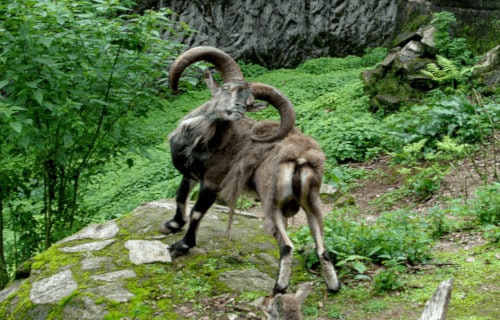
CCL: https://bit.ly/1xMszCg
Bharal Facts
- Our fifth entry into this compilation of 6 Beautiful Bovines, the Bharal, places there only due to random selection.
- The truly astonishing Bharal lives in an extremely rugged and remote section of Asia. So remote is its habitat range, that few outsiders ever see this amazing creature. Therefore, and quite unfortunately, this animal has been little-studied.
- The first serious scientific observations of this ruminant did not occur until the year 1973. Previously, this fascinating recluse of Nature had been thought to be a variety of sheep. Recent DNA analysis of the Bharal actually reveals a much closer relationship to goats.
- Interestingly, this surprising species plays a unique role. The creature has long enjoyed a special relationship with the occupants of numerous Buddhist monasteries in its endemic range, who often protected the creatures.
- Sadly, however, concerns over Bharal-related crop damage have begun to arise in portions of its natural range. This has had a regrettable result. It has, in fact, been putting pressure on those who strive to protect it.
- For the moment, however, the IUCN lists it as Least Concern. This appears on the organization’s Red List. Nevertheless, it must be considered to be at risk from the ongoing effects of climate change, like other species.
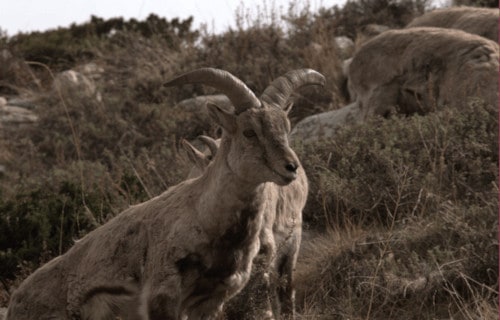
Bharal Physical Description
The beautiful Bharal ranks as a medium-sized form of caprid, which is a type of ruminant. This magnificent animal does display the trait of sexual dimorphism, but only a slight degree. The males grow slightly larger and heavier than the females.
Overall, the animal attains an average head and body length of roughly 65 in (165 cm). The short, rather stubby tail adds, at most, an additional 7.9 in (20 cm) to its length. The largest individual observed to date measured 36 in (91 cm) tall at the shoulder.
The Bharal coat grows short and comparatively quite dense. It also typically displays a slate gray color, commonly with a bluish sheen. The belly and part of the legs generally present a white color, while the chest and front of the legs usually show black.
Quite surprisingly, both genders grow horns. In this manner, the bovine distinguishes itself form the majority of related species. Furthermore, among males, these grow to lengths of as much as 31 in (80 cm), while those of the female rarely exceed 8 in (20.3 cm).
- Kingdom: Animalia
- Phylum: Chordata
- Class: Mammalia
- Order: Artiodactyla
- Family: Bovidae
- Genus: Pseudois
- Species: P. nayaur
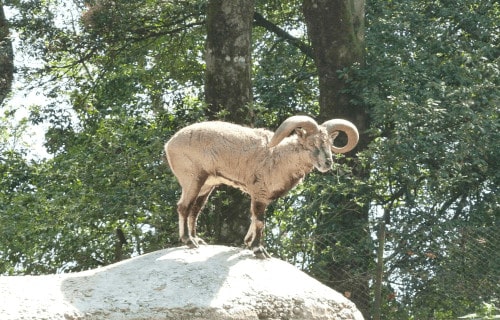
CCL: https://bit.ly/1p2b8Ke
Bharal Distribution, Habitat, and Ecology
The stunning Bharal also evolved as native to a quite harsh region. That’s also a highly restricted portion of Asia. This range includes portions of what we now know as the five countries of India, Bhutan, Nepal, Pakistan, and Tibet.
Within that range, however, the creature only inhabits a very specific type of habitat. Firstly, it only lives on high mountain slopes. Secondly, though, the impressive bovine typically lives on those that contain numerous rocky cliffs and ledges.
These, the animal quite effectively uses both characteristics of its environment for camouflage and defense. Its natural coloring allows it to blend in quite well with the color of the native stone. This provides it some protection from predators.
Furthermore, the Bharal also has good instincts. Individuals rarely stray more than 650 ft (200 m) from the ledges and cliffs. In addition, its surefooted nature commonly allows it to escape attacking predators by leaping onto tiny ledges.
The species also holds another surprise for those who learn of it. Within its native range, this fabulous marvel of Nature actually has very few natural predators. However, it nevertheless does have a few of them, as most creatures do.
Its most common natural predators primarily include the gorgeous Snow Leopard. Nevertheless, it also sometimes falls prey to human hunters. But, its main threat actually consists of competition from livestock for available food sources.
Chamois
Chamois Facts
- The final entry into this article about 6 Beautiful Bovines is the beautiful animal known as the Chamois.
- First of all, the relatively simple term of Chamois serves as the common name for a truly remarkable variety of mammal. That’s fortunate, because the fascinating animal has a small burden to bear.
- Quite regrettably, the animal sadly has a somewhat confusing scientific name. In point of fact, this consists of Rupicapra rupicapra. But, by either name one uses, it represents a highly interesting species.
- Furthermore, several subspecies of the Chamois also exist, and are themselves quite interesting creatures. Fortunately, at least some of these subspecies currently enjoy legal protection in the areas in which they appear.
- This animal does have other names in other languages. But the term most often used for it by scientists comes from the French, chamois. Its population numbers do appear to be beginning to diminish. Yet, for the moment, these appear to be sufficient.
- Therefore, the IUCN lists the Chamois as Least Concern. Nonetheless, it must be considered to be facing several threats to its existence. The greatest of these, much like other species around the world, include habitat loss and climate change.
Chamois Physical Description
Perhaps most notably, the remarkable Chamois impresses with many qualities. Size, however, does not rank as one of them. To the great surprise of many people, the remarkable animal actually ranks as a very small variety of bovid.
But, though it’s not as large as most related species, it does share another trait. That’s because of the fact that, like the great majority of bovids, this fascinating animal displays a moderate degree of the physiological trait of sexual dimorphism.
Mature adults of both genders attain an average height at the shoulder of roughly 28 – 31 in (70 – 80 cm). In addition, an average body length for both equals about 42 – 54 in (107-137 cm). The tail remains unseen except during mating.
However, the first of two slight differences appear in terms of weight. That’s because males typically grow slightly heavier. Firstly, mature males can reach 132 lb (60 kg) in weight. Meanwhile, the smaller females of the Chamois rarely exceed 99 lb (45 kg).
The second manner in which the Chamois distinguishes the sexes appears with the horns. In the case of this species, both genders develop these. Further, they grow short but straight. But those of the male usually have a thicker form.
In addition, the fur of both sexes shows a deep brown in the summer. However, this turns to a pale gray color in the winter. White marks on the side of the head and black stripes under the eyes complete the remarkable markings.
- Kingdom: Animalia
- Phylum: Chordata
- Class: Mammalia
- Order: Artiodactyla
- Family: Bividae
- Genus: Rupicapra
- Species: R. rupicapra
Chamois Distribution, Habitat, and Ecology
The magnificent Chamois boasts another impressive statistic. The animal actually inhabits a comparatively broad section of the world. In fact, this zone of habitation spreads across two separate continents. That’s because of the fact that it lives in both Europe and Asia.
More precisely, this supremely gorgeous mammal lives in the countries of Turkey and the Caucasus in Asia. It also lives in the Pyrenees, in portions of Europe. Given this natural range, the type of habitat it inhabits seems predetermined.
That’s due to the fact that the incredible mammal evolved as endemic to moderately high altitudes. Furthermore, it thrives in highly rocky and rugged terrain. Individuals appear at heights between 11,800 ft (3,600 m) in summer, and 2,600 ft (800 m) in the winter.
Much like its many related species, the marvelous Chamois evolved as what one might expect. This holds true since it lives as an entirely herbivorous creature. In its case, it primarily consumes a variety of locally varying vegetation.
However, its diet remains quite seasonal. The great majority of this includes herbs and grasses during summer. But, then it feeds on various tree needles and bark in the winter. It also evolved has a mainly diurnal behavioral pattern.
Mature males most commonly live a solitary life. The lone exception to this appears to be during mating season. Meanwhile, females and the young live almost exclusively in herds. Further, these generally number between 15 – 30 individuals.
Currently, human hunters continue to form its main predator, even today. Its leading natural predators, though, include several powerful creatures. These consist of such species as Persian leopards, gray wolves, and Eurasian Lynxes.
6 Beautiful Bovines
We sincerely hope that you have thoroughly enjoyed this article about 6 Beautiful Bovines. Because a few of the many species have been domesticated by man, many of their related creatures often go overlooked and underappreciated. We hope that perusing this article has helped to change that. Sadly, though, many of them now find themselves in danger of potential extinction. It’s up to all of us to do all that we can to protect and preserve these 6 Beautiful Bovines, and all the others, as well, for posterity.
Check out our other articles on 7 Highly Unusual Lakes, 7 Bizarre Ocean Invertebrates, 8 Geological Wonders of North America, Spectacular Dolphins Throughout Our World
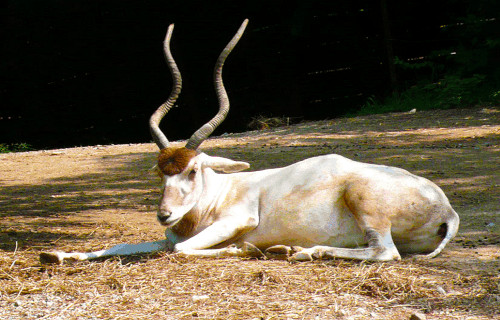
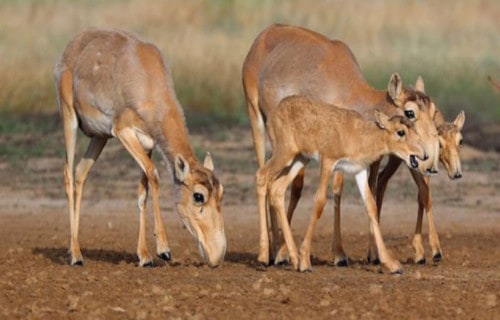
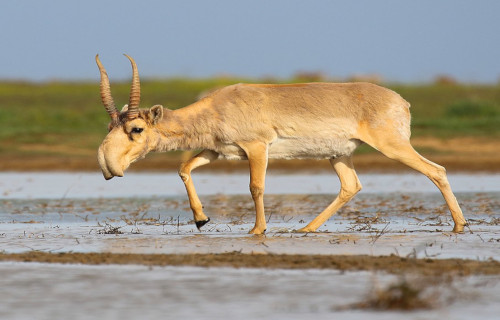
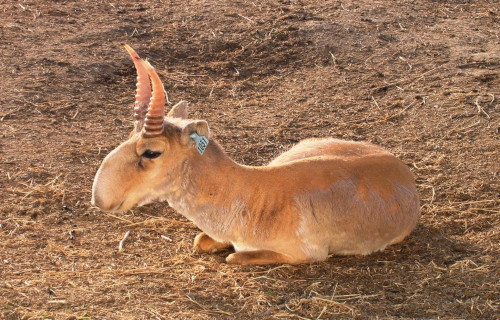
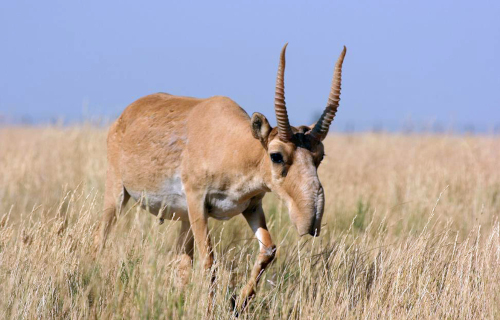
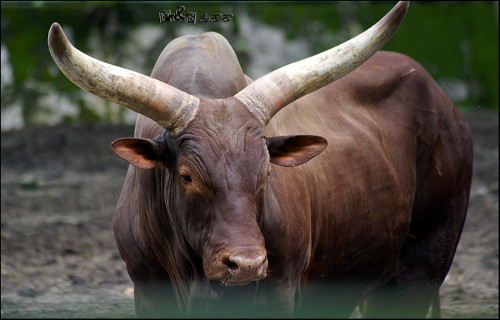
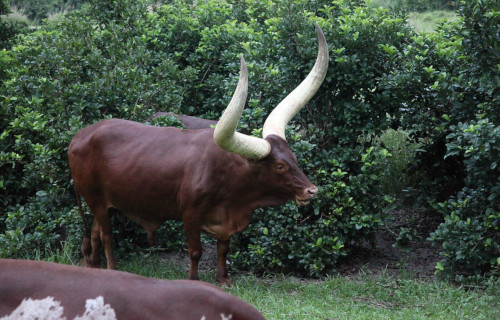
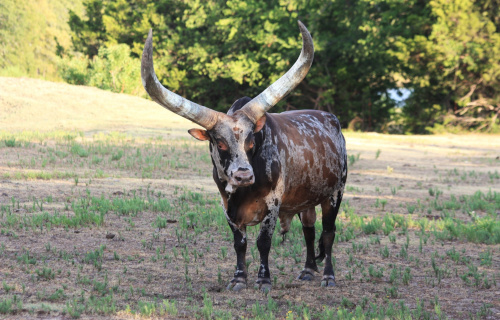
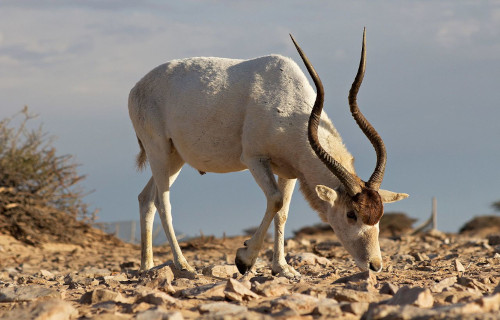
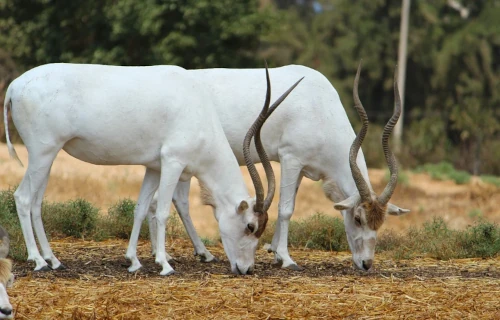
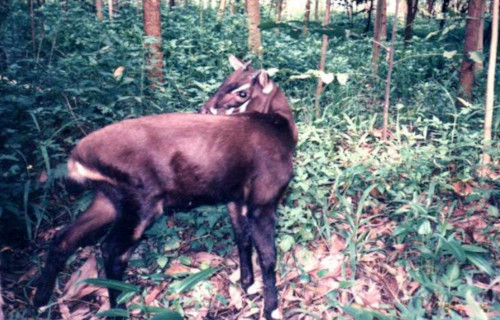
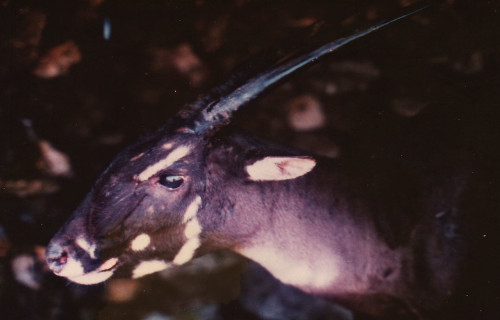
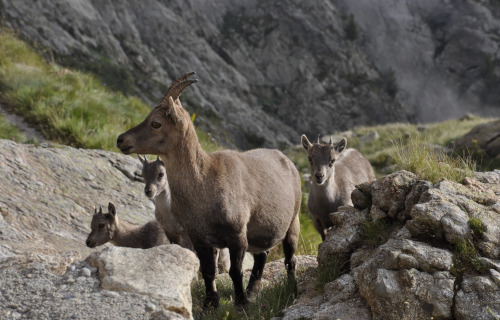
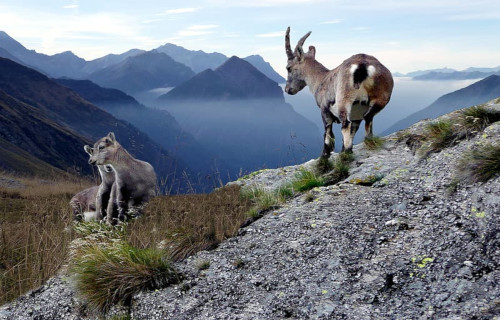
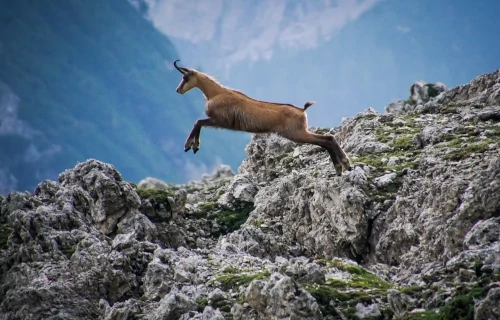









Leave a Reply